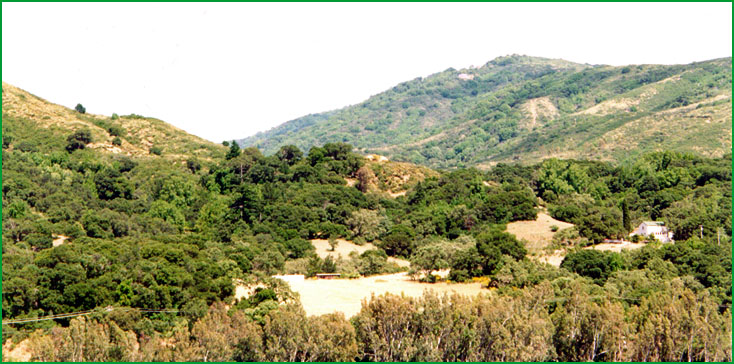 | Subsection g - Leeward Hills |
Leeward hills near Lexington Resevoir Ś Scott Miles |
from http://www.fs.fed.us/r5/projects/ecoregions/261ag.htm
This subsection is on the interior, or northeast, side of the Santa Cruz Mountains that is between the San Andreas fault and the alluvial plain in the Santa Clara Valley and at the south end of San Francisco Bay. It is much drier than the seaward side of the mountains (subsection 261Af). The climate is hot and subhumid, with moderate marine influence. MLRAs 14d and 15d.
Lithology and Stratigraphy. This subsection consists mostly of folded, faulted, and generally metamorphosed sediments and volcanics of the Franciscan Complex and less extensive Cretaceous sediments of the Great Valley Sequence. There are dissected Plio - Pleistocene nonmarine sediments along the lower, or northeast, margin of the subsection, and small areas of Tertiary (Miocene etc.) marine sediments.
Geomorphology. This is a subsection of northwest trending mountains and hills with steep sides and narrow canyons. The crest of the mountain range is near the northeast edge of the mountain range, parallel to the San Andreas Fault, which is along the northeast side of the Santa Cruz Mountains. Most of the streams on the leeward side that drain toward the northeast are relatively short. The San Andreas fault is near the southwest edge of the subsection, but generally in the adjacent subsection. The subsection elevation range is from about 200 feet up to 3790 feet on Loma Prieta. Mass wasting and fluvial erosion are the main geomorphic processes.
Soils. The soils are mostly Lithic Xerorthents, Lithic Ruptic - Xerochreptic Haploxeralfs, and Ultic Haploxeralfs. On Tertiary marine and Plio-Pleistocene nonmarine sediments, they are mostly Xerorthents, Typic Haploxeralfs, and Typic Argixerolls. The soils are well drained, and most of them are leached free of carbonates. Soil temperature regimes are mostly thermic (nearly mesic), and some mesic. Soil moisture regimes are xeric (nearly ustic).
Vegetation. The predominant natural plant communities are Coast live oak series and California bay series on north-facing slopes, Blue oak series on south-facing slopes, and Chamise series on shallow soils.
Characteristic series by lifeform include:
Grasslands: California annual grassland series.
Shrublands: Chamise series, Coyote brush series.
Forests and woodlands: Blue oak series, California bay series, Coast live oak series, Mixed oak series.
Climate. The mean annual precipitation is about 15 to 30 inches. It is practically all rain, except for some snow on at higher elevations. Mean annual temperature is about 50░ to 60░ F. The mean freeze-free period is about 225 to 275 days.
Surface Water. Runoff is rapid and the streams are generally dry during the summer. There are no natural lakes, but numerous reservoirs.
